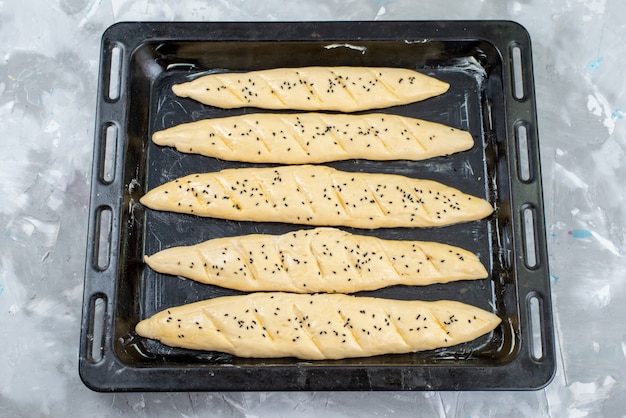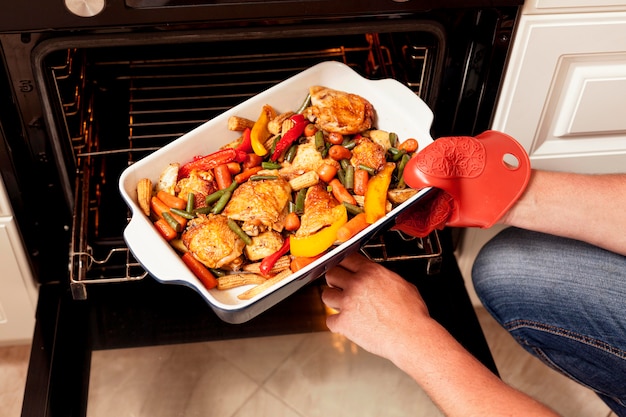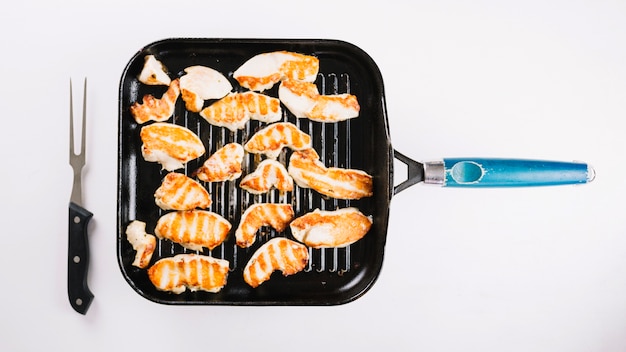Ah, brats. Those plump little sausages, the undisputed champions of backyard barbecues and summertime gatherings. The aroma alone is enough to make your mouth water and your heart sing. While grilling is the classic method for achieving that smoky char, there's a hidden gem in the world of brat cooking: oven-baking. It's a revelation, trust me. Oven-baked brats are just as juicy, flavorful, and satisfying as their grilled counterparts, but without the fuss and mess of firing up the grill.
So, let's embark on a journey into the delicious world of oven-baked brats. We'll cover everything from choosing the perfect sausage to mastering the art of a crispy sear. I'll share my personal tips, tricks, and favorite flavor combinations, because, let's be honest, brats are meant to be savored, not just cooked.
(Part 1) Choosing Your Brats: A Sausage Odyssey

The Great Brat Debate: Fresh vs. Pre-Cooked
First things first, you've got to make a decision: fresh or pre-cooked. It's a classic dilemma, and the choice depends on your preferences and how much time you're willing to invest. Fresh brats are like blank canvases, waiting for you to add your own culinary strokes. They're uncooked, so you'll be taking them from raw to sizzling perfection. This gives you complete control over the cooking process and ensures the most authentic brat experience.
Pre-cooked brats, on the other hand, are already partially cooked, meaning they just need a quick heat-up. They're a great option for those busy weeknights when you need a quick and easy dinner. But be warned: pre-cooked brats tend to be a bit drier, so you might need to add some extra moisture, like a flavorful sauce or marinade, during baking.
For me, there's something incredibly satisfying about taking a fresh brat from its raw state to that perfect, golden-brown finish. It's a bit of a culinary journey, and I love the control it gives me over the final product. But I'll admit, there's nothing wrong with a good pre-cooked brat for a weeknight dinner.
Choosing the Right Breed: Beyond the Basic Brat
Now, let's talk varieties. Gone are the days of just basic, plain brats. The sausage world has expanded, offering an incredible range of flavors and styles. You've got your classic German brats, usually a blend of pork and beef, with a satisfying snap and a hint of spice. Then there are the more adventurous options, like italian sausages, bursting with savory herbs and spices, or Polish kielbasa, known for its smoky depth.
There are even brats made with chicken or turkey for a lighter option, or, if you're feeling daring, try lamb or veal brats. It's a whole new world of sausage exploration, and there's something out there for every palate.
My personal preference? I'm a sucker for a good old-fashioned German brat, but I'm always open to trying new things. Don't be afraid to venture outside your comfort zone and discover your own favorite sausage style.
(Part 2) Getting Ready to Bake: The Pre-Bake Prep

The Tools of the Trade: Essential kitchen equipment
You don't need a fancy, top-of-the-line kitchen to bake brats. A few basic tools are all you need to create a delicious and satisfying meal.
- A Baking Sheet: This is your workhorse, the foundation upon which your brat-baking journey will be built. You want a sturdy baking sheet, preferably one with a lip to catch any drips and spills.
- A Wire Rack: This is a game-changer. The wire rack lifts the brats off the bottom of the baking sheet, allowing for even cooking and preventing them from getting soggy. It's a simple but brilliant solution for achieving that perfect crispy texture.
- A Basting Brush: This handy tool is essential for applying any sauces, glazes, or marinades you choose to use during the baking process.
Now, if you're feeling a bit tight on space or don't have a wire rack, you can definitely skip it. Just remember to turn the brats halfway through baking to ensure they cook evenly.
Preparing the Brats: Setting the Stage for Success
Once you've gathered your tools, it's time to prep the brats. This is where the real magic happens.
For fresh brats, give them a good rinse under cold water to remove any excess debris and pat them dry with paper towels. This ensures even cooking and helps to achieve that beautiful golden-brown crust.
Pre-cooked brats don't require rinsing, but you might want to pat them dry to encourage browning in the oven. A little bit of pre-bake drying goes a long way in creating that crispy texture we're aiming for.
(Part 3) The Oven-Baking Process: From Raw to Ready

Preheat, Position, and Place: Setting the Oven Stage
Alright, let's get baking! First, preheat your oven to 375°F (190°C). This ensures that the oven is hot enough to cook the brats evenly and quickly, without over-drying them.
Next, position the rack in the middle of the oven. This allows the heat to circulate evenly around the brats, resulting in perfect cooking from all sides.
Now, it's time to place the brats. If you're using a wire rack, place the brats directly on the rack. If you're skipping the rack, lay the brats out on the baking sheet, ensuring there's enough space between each sausage to allow for airflow and even browning.
Bake It 'Til You Make It: Time for a Brat Bake-Off
Alright, let's get down to business! The bake time will vary depending on whether you're using fresh or pre-cooked brats.
For fresh brats, bake them for about 20-25 minutes, or until they reach an internal temperature of 160°F (71°C). You can use a meat thermometer for the most accurate reading.
For pre-cooked brats, you'll need a little less time, about 10-15 minutes, or until they're heated through and browned. Remember, you're just looking to warm them up and give them a nice crispy sear.
Turning for That Golden-Brown Glory: The Secret to a perfect sear
Here's where the real magic happens: turning those brats halfway through baking. This is essential for achieving that beautiful, even browning and prevents them from getting too dry on one side.
For fresh brats, turn them after about 10-12 minutes. For pre-cooked brats, you can turn them after about 5-7 minutes. Use tongs or a spatula to carefully flip them, making sure to maintain their shape.
(Part 4) Adding Flavor to Your Brats: The Art of the Brat Brush
The Power of the Brushing: Taking Your Brats to the Next Level
A simple bake won't be enough to truly make your brats sing. This is where the magic of brushing comes in. You can use a variety of sauces, glazes, or marinades to elevate the flavor profile of your brats.
Here are some of my favorite go-to brat brushes, sure to tantalize your taste buds:
- Mustard: A classic for a reason. A good Dijon or stone-ground mustard will add a tangy kick and a nice caramelized crust.
- bbq sauce: A sweet and smoky barbecue sauce is always a crowd-pleaser. Just make sure to use a high-quality sauce with a good balance of flavor.
- Honey Mustard: Sweet, tangy, and slightly spicy, honey mustard is a great all-around choice for brats.
- Beer: Yes, you read that right! Beer can be used as a basting sauce for brats, adding a subtle malt flavour and helping to keep them moist.
Experiment with different combinations. A touch of paprika, garlic powder, or onion powder can add a burst of flavor.
Don't Forget the Sides: The Perfect Brat Ensemble
No brat is complete without a delicious array of side dishes. Here are a few of my favorites that complement the savory flavors of the sausage perfectly:
- Sauerkraut: A classic German accompaniment, sauerkraut is tangy, fermented cabbage that pairs perfectly with brats.
- potato salad: A creamy and comforting side, potato salad is a staple at any barbecue.
- Coleslaw: A refreshing and crunchy contrast to the richness of the brats, coleslaw is a great way to balance out the flavors.
- Baked Beans: Sweet, smoky, and hearty, baked beans are a perfect match for brats.
Don't be afraid to get creative with your side dish choices. A mac and cheese or a fresh green salad can also be delightful pairings. It's all about finding what you enjoy most!
(Part 5) Mastering the Brat-Baking Technique: Achieving Crispy Perfection
The Art of the Sear: That Golden-Brown Crust We All Crave
Let's talk about that crispy, golden-brown crust that elevates your brats from good to amazing. You can achieve this with a quick sear under the broiler just before serving.
Here's how:
- Pre-Heat the Broiler: Preheat your oven’s broiler to high.
- Position the Rack: Move the oven rack to the highest position.
- Transfer the Brats: Carefully transfer your brats from the baking sheet to a baking pan or a wire rack that can fit under the broiler.
- Broil 'Em Up: Broil for 2-3 minutes, or until the brats are browned and slightly crispy. Keep a close eye on them as they can burn quickly.
Be careful when handling the pan or rack after broiling. It will be very hot!
Beyond the Oven: Expanding Your Brat Horizons
For those who yearn for the smoky flavor that only grilling can provide, there's always the option of grilling your brats. Just remember to pre-heat your grill to medium heat, cook the brats for about 10-15 minutes, turning them halfway through to ensure even cooking.
And for the true barbecue aficionados, there's always smoking. Smoking brats takes a bit more time and effort, but the results are truly special. Just be sure to follow the instructions for your smoker carefully.
(Part 6) Elevating Your Brat Game: From Basic to Brilliant
Brat-Making at Home: Taking Control of Your Sausage Destiny
For those who crave a true sense of culinary control, why not try making your own brats from scratch? It's easier than you might think, and it gives you complete freedom to customize your sausage with your favorite flavors and spices.
You'll need a good meat grinder and a few basic ingredients:
- Ground Pork: The base of your brat.
- ground beef: Adds flavor and texture.
- Spices: You can use a blend of spices like paprika, garlic powder, onion powder, pepper, and coriander.
- Water: Helps to bind the ingredients.
- Casings: These are the skins that hold the sausage together. You can find them at most butcher shops or online.
Once you have all your ingredients, simply grind the meats, add the spices, mix well, stuff the casings, and you're good to go!
The Ultimate Brat Bundle: Creating Your Own Sausage Platter
Now, let's talk about presentation. A sausage platter is a perfect way to impress your guests and elevate your brat game to new heights.
Here are the essential elements of a killer brat platter:
- Variety of Brats: Offer different flavours and styles of brats, from classic German to spicy Italian.
- Side Dishes: Include a selection of classic side dishes like sauerkraut, potato salad, coleslaw, and baked beans.
- Dips and Sauces: Provide a variety of dips and sauces for guests to customize their brats, like mustard, BBQ sauce, honey mustard, ketchup, and relish.
- Bread: Offer a variety of breads for serving your brats, like slider buns, hoagie rolls, or even crusty bread.
- Garnish: Add a touch of elegance with fresh herbs like parsley, chives, or dill.
Arrange your platter beautifully on a large serving platter or a wooden cutting board. And don’t forget to have fun with it!
(Part 7) The Science Behind the Brat: Unveiling the Sausage Secrets
Understanding Brat Anatomy: A Deep Dive into Sausage Structure
Let's take a moment to delve a bit deeper into the science of the brat. The typical brat is made from a mixture of ground meats, spices, and sometimes other ingredients like milk or eggs. The meat is usually pork or a blend of pork and beef. The spices are what give the brat its unique flavor, and they can range from simple blends of salt and pepper to more complex combinations of paprika, garlic powder, onion powder, and other herbs and spices.
The sausage is then stuffed into a casing, which is usually made from natural or synthetic material. The casing helps to hold the meat together and gives the sausage its shape. The brats are typically cooked by grilling, baking, or smoking, which helps to render the fat and create a crispy crust.
The Importance of Fat Content: The Key to Juicy Perfection
The fat content of your brats plays a crucial role in their flavor and texture. Fat renders during cooking, creating a juicy and flavorful sausage. However, too much fat can make the sausage greasy and difficult to cook evenly. A good balance of lean and fat is key for a perfectly cooked brat.
Look for brats with a fat content between 15% and 20% for a juicy and flavorful sausage that isn’t too greasy.
The Casing Conundrum: Natural vs. Synthetic
You might be wondering about the different types of casings available. natural casings are made from animal intestines, while synthetic casings are made from cellulose or collagen.
Natural casings are usually considered to be more flavorful and give the sausage a slightly crispier texture. However, they can be more difficult to work with and may have a slight aftertaste.
Synthetic casings are more uniform and easier to work with, but they may not be as flavorful as natural casings. Ultimately, the type of casing is a matter of personal preference.
(Part 8) FAQs: Answering Your Brat-Baking Questions
Q1: Can I Freeze Brats?
Yes, you can absolutely freeze brats! Freezing is a great way to extend their shelf life. Just make sure to wrap them tightly in plastic wrap or freezer paper before storing them in the freezer. To thaw frozen brats, simply transfer them to the refrigerator overnight. You can also thaw them in the microwave or under cold running water.
Q2: How Long Can I Keep Brats in the Refrigerator?
Unopened brats can be stored in the refrigerator for 1-2 days. Once you’ve opened them, you’ll want to use them within 1-2 days. It’s always a good idea to check the expiration date on the package to ensure the brats are still fresh.
Q3: What's the Best Way to Reheat Brats?
The best way to reheat brats is in the oven. Preheat the oven to 350°F (175°C) and bake the brats for about 10-15 minutes, or until they are heated through. You can also reheat brats in the microwave, but they may become a bit dry.
Q4: What’s the Best Temperature to Cook Brats?
The ideal internal temperature for cooked brats is 160°F (71°C). You can use a meat thermometer to check the temperature for accuracy.
Q5: What Can I Do With Leftover Brats?
Leftover brats can be used in a variety of recipes. You can slice them up and add them to soups, stews, or chili. They also make a great addition to pasta dishes or pizza. You can also use leftover brats to make sausage sandwiches or breakfast burritos. Get creative and experiment with different recipes!
So, there you have it, folks. The ultimate guide to oven-baked brats, from choosing the perfect sausages to mastering the art of the perfect sear. Remember, the key is to experiment and find what you enjoy most. So get in the kitchen, fire up the oven, and let’s make some brats!
Everyone is watching

Corn on the Cob: The Ultimate Guide to Perfectly Cooked Ears
Healthy MealsAh, corn on the cob. Just the name evokes images of sunny days, barbecues, and that sweet, juicy flavour that ...

Perfect Pork Roast Oven Cooking Time: A Guide to Delicious Results
Healthy MealsThere's something truly satisfying about a perfectly roasted pork. The aroma alone is enough to make your mout...

Scallops: The Ultimate Guide to Perfect Cooking
Healthy MealsAh, scallops. Those delicate, sweet, and utterly delicious morsels of the sea. They hold a special place in my...

Ham Cooking Time: How Long to Bake, Smoke, or Boil a Delicious Ham
Healthy MealsAh, ham. It's a classic, isn't it? A real crowd-pleaser, especially around holidays. And when done right, it'...

Spaghetti Squash: The Ultimate Guide to Cooking and Serving
Healthy MealsRemember that time you saw spaghetti squash at the supermarket, looking all bumpy and strange, and thought, "W...
